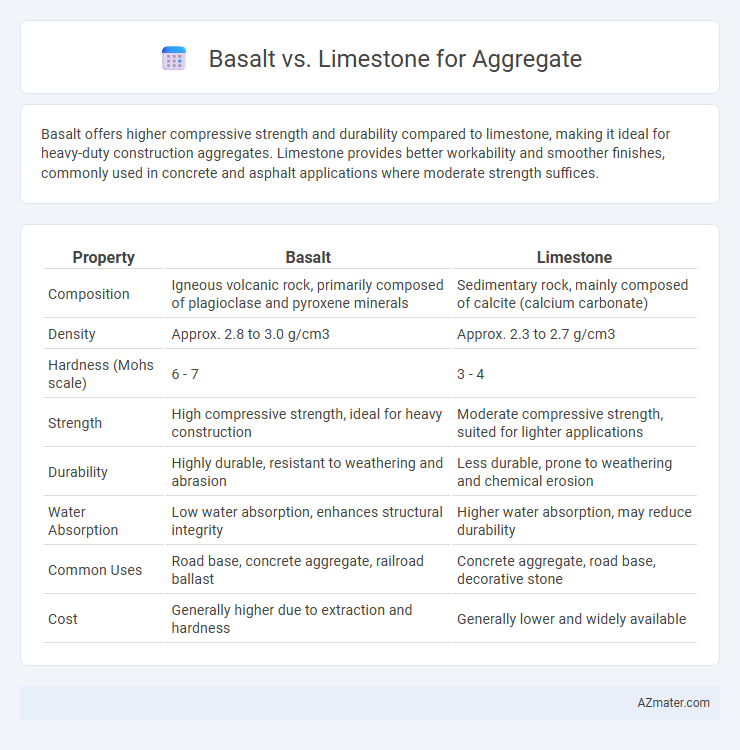Basalt offers higher compressive strength and durability compared to limestone, making it ideal for heavy-duty construction aggregates. Limestone provides better workability and smoother finishes, commonly used in concrete and asphalt applications where moderate strength suffices.
Table of Comparison
| Property | Basalt | Limestone |
|---|---|---|
| Composition | Igneous volcanic rock, primarily composed of plagioclase and pyroxene minerals | Sedimentary rock, mainly composed of calcite (calcium carbonate) |
| Density | Approx. 2.8 to 3.0 g/cm3 | Approx. 2.3 to 2.7 g/cm3 |
| Hardness (Mohs scale) | 6 - 7 | 3 - 4 |
| Strength | High compressive strength, ideal for heavy construction | Moderate compressive strength, suited for lighter applications |
| Durability | Highly durable, resistant to weathering and abrasion | Less durable, prone to weathering and chemical erosion |
| Water Absorption | Low water absorption, enhances structural integrity | Higher water absorption, may reduce durability |
| Common Uses | Road base, concrete aggregate, railroad ballast | Concrete aggregate, road base, decorative stone |
| Cost | Generally higher due to extraction and hardness | Generally lower and widely available |
Introduction to Aggregate Materials
Aggregate materials like basalt and limestone are essential components in construction, serving as the foundation for concrete, asphalt, and road base layers. Basalt, a volcanic igneous rock, offers high durability and strength, making it ideal for heavy-load applications, while limestone, a sedimentary rock composed mainly of calcium carbonate, provides good workability and is often used in cement production. The choice between basalt and limestone aggregates depends on specific project requirements such as strength, abrasion resistance, and environmental conditions.
Basalt and Limestone: Geological Overview
Basalt is an igneous rock formed from rapidly cooling lava, characterized by its fine-grained texture and high density, making it a durable choice for aggregate in construction. Limestone, a sedimentary rock composed mainly of calcium carbonate, forms from accumulated marine organism remains and exhibits a softer texture compared to basalt. The geological formation processes of basalt result in a stronger and more abrasion-resistant aggregate, whereas limestone's porosity and mineral composition influence its suitability in specific civil engineering applications.
Physical Properties Comparison
Basalt exhibits higher compressive strength and greater density compared to limestone, making it more suitable for high-load construction applications. Limestone has a lower abrasion resistance and tends to be softer, resulting in faster wear in road aggregates. The porosity of basalt is lower, contributing to better durability and less water absorption than limestone in aggregate use.
Durability and Strength Differences
Basalt offers superior durability and higher compressive strength compared to limestone, making it ideal for heavy-duty construction projects. Limestone is softer and more porous, which can lead to faster wear and reduced lifespan under high-stress conditions. In applications requiring long-term structural integrity and resistance to abrasion, basalt aggregates are preferred due to their robust mineral composition and density.
Suitability for Construction Applications
Basalt is highly suitable for construction applications due to its high compressive strength, durability, and resistance to abrasion, making it ideal for road bases, concrete aggregates, and heavy-duty pavement. Limestone offers excellent workability and ease of processing, with moderate strength suitable for lighter construction needs such as mortar, road base, and decorative aggregates. Basalt's dense, hard composition withstands aggressive environmental conditions better than limestone, which is more prone to weathering and acid attack, influencing long-term structural performance.
Performance in Asphalt and Concrete Mixes
Basalt offers superior durability and high compressive strength compared to limestone, enhancing the load-bearing capacity and longevity of asphalt and concrete mixes. The dense, non-porous nature of basalt improves resistance to abrasion and weathering, making it ideal for heavy traffic pavements. Limestone, with its calcium carbonate content, provides good workability and bonding but may exhibit lower abrasion resistance and durability in freeze-thaw cycles, affecting long-term performance.
Environmental Impact and Sustainability
Basalt, a volcanic igneous rock, offers higher durability and lower porosity compared to limestone, resulting in less frequent replacement and reduced environmental disruption over time. Limestone, derived primarily from marine sedimentation, has a lower carbon footprint during extraction but can contribute to higher dust and acidification risks in nearby ecosystems. Sustainable aggregate sourcing favors basalt when prioritizing longevity and erosion resistance, while limestone requires careful management to minimize environmental degradation.
Cost and Availability Analysis
Basalt aggregate typically costs more than limestone due to its higher density and superior durability, making it ideal for heavy-duty construction projects. Limestone is more widely available and generally more affordable, especially in regions with abundant sedimentary rock deposits, which reduces transportation expenses. Cost-effectiveness depends on local material supply, quarry proximity, and project specifications demanding either basalt's strength or limestone's cost-efficiency.
Maintenance and Longevity Factors
Basalt aggregates exhibit superior durability and resistance to wear, making them ideal for high-traffic infrastructure projects requiring minimal maintenance over time. Limestone aggregates, while more cost-effective initially, are prone to weathering and chemical erosion, leading to increased maintenance needs and shorter lifespan in harsh environments. The denser, harder composition of basalt significantly extends pavement longevity compared to the softer, more porous nature of limestone.
Choosing the Right Aggregate: Basalt vs Limestone
Basalt offers superior durability and higher compressive strength, making it ideal for heavy-duty construction projects and high-traffic roads, while limestone provides better workability and is more cost-effective for general construction and concrete production. The decision between basalt and limestone aggregates depends on project-specific requirements such as load-bearing capacity, exposure to environmental conditions, and budget constraints. Evaluating factors like hardness, absorption rate, and environmental impact ensures optimal performance and longevity in construction applications.

Infographic: Basalt vs Limestone for Aggregate
 azmater.com
azmater.com